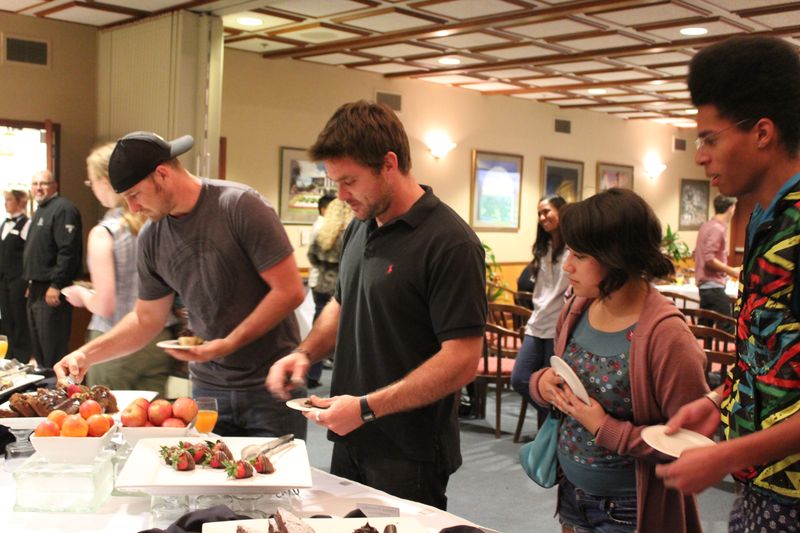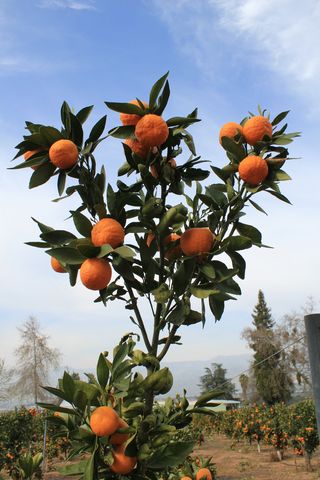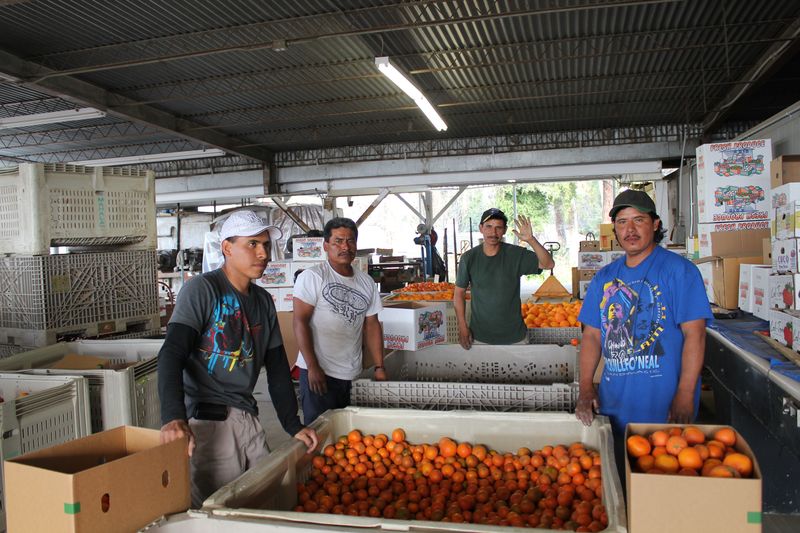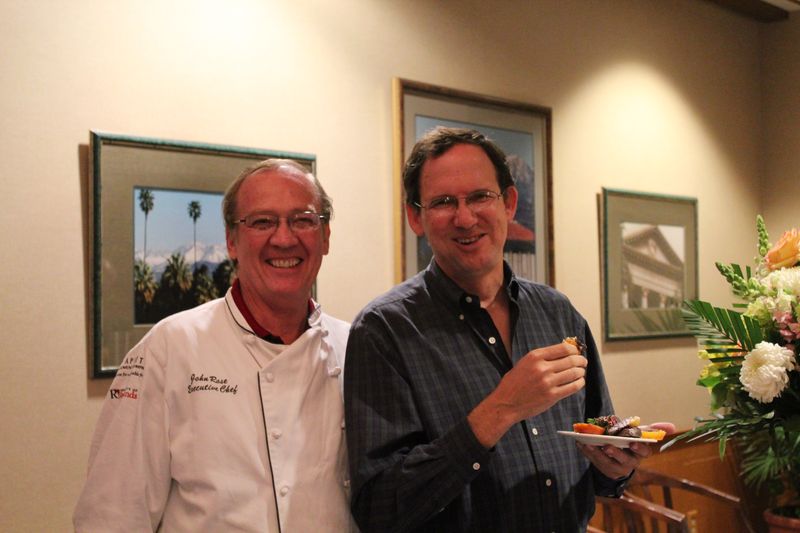Lessons from the old grove: Industrial and humane agriculture do not mix well
- by Vera Chang

University of Redlands students trying Old Grove oranges and other treats dipped in Cordillera fair trade chocolate at Stories from the Fields
By Vera Chang, West Coast Fellow for Bon Appétit Management Company Foundation
 Industrial-scale agriculture often exacts a steep human cost. That was one of the lessons I learned last week from farmer Bob Knight and farmworker Marco Franco of the Inland Orange Conservancy, Bon Appétit at the University of Redland’s first Farm to Fork partner. They were the guest speakers at one of our Stories from the Fields events, held at the University Club.
Industrial-scale agriculture often exacts a steep human cost. That was one of the lessons I learned last week from farmer Bob Knight and farmworker Marco Franco of the Inland Orange Conservancy, Bon Appétit at the University of Redland’s first Farm to Fork partner. They were the guest speakers at one of our Stories from the Fields events, held at the University Club.
What is “industrial agriculture,” exactly? For citrus farmers, it means growing at a scale and price suitable for the global market. Oranges are simply commodities: the bigger, shinier, and more perfectly rotund, the better. Flavor, locality, agricultural and labor practices, and the story of where that food came from and who was involved are regarded secondarily, if at all. So-called “old groves,” which house citrus trees as old as 100 years, are rare today. And while these groves produce some of the most intensely flavorful fruits I’ve tasted, old-grove farmers have great trouble selling their fruit. Why? Cosmetic reasons: size and shape.
Sunkist, the world’s leading citrus supplier, is a not-for-profit cooperative, but some of its farmers still receive incredibly low prices for their fruit. (As I discussed in an earlier post, whereas supermarkets charge roughly $100 for an orange “field box,” or 55 pounds of oranges, Sunkist farmers in the Redlands area commonly receive just $1.) When Sunkist comes to a grove to pick, they “won’t tell you what price you’re going to get in advance,” Bob explained. “Assuming that you did make some money, they won’t pay you until three months later. And sometimes they don’t even pay you. Instead, they’ll send you a bill that says that the revenue of selling those oranges was not enough to cover the cost of picking and packing the oranges, and so you owe them money. But they don’t tell you that in advance.”
The result? Most Southern California citrus growers don’t manage to break even. No matter how many generations the land has been in the family or how passionate farmers are, they are losing their livelihood. Orange groves used to carpet San Bernardino and Los Angeles counties, but in the past 20 or so years, roughly three-quarters have been paved over.
And it’s not just the farmers who are being screwed over in the global system. Alongside the citrus that they pick, farmworkers too are treated like commodities, or as a convenient economic means (labor) to an end (profit). Bob said that when his father used to farm, he employed workers directly. Today, manpower is supplied mostly via labor contractors.
Farm Labor Contractors, or FLCs, are intermediaries that, for a fee, will recruit, solicit, employ, supply, transport, and/or hire agricultural workers. Growers pay the FLC a lump sum; in exchange, the FLC will make sure that any given task (e.g., picking, packing) is completed. They assume responsibility for everything that has to happen along the way, from paying wages to assuring legal compliance to liability insurance to even providing portable toilets. Of California’s estimated 471,000 farmworkers, roughly 50% to 75% are hired through FLCs.
In addition to handling all the logistics, FLCs offer savings. Labor costs account for a whopping 50% to 65% of total farm costs. With such tight profit margins, cutting these costs is one palpable way growers can try to hold onto their business.
But while FLCs provide cheap labor, they do so at the expense of the worker: low farmworker wages, systematic abuse, and lack of legal compliance are shockingly common.
Last week, the University of Redlands audience got to put a face to these figures, with farmworker Marco Franco.
I first met Marco in the Inland Orange Conservancy packing shed, where he was working alongside three of his brothers. “When I was working for the [farm labor] contractor,” Marco explained, “they paid us very little. Every day we had to wake up at 4 a.m., and then we wouldn’t go back home until 6 p.m. and sometimes not until 9 p.m. It was really hard work, and we didn’t… get insurance and they didn’t ever give us overtime.” Marcos and his brothers made $15 for picking one orange box, which would take an hour and a half. Grapefruits could sometimes take three hours to fill one bin, for which they were paid only $25. And if they were sick or not working, for example, waiting in the fields for an assignment, in transportation from one field to the next, then they didn’t get paid at all.
Marco began this work when he was just 15 years old, legal for work in agriculture under the Fair Labor Standards Act. Marco’s story is not atypical.
When Bob Knight and the other “Sunkist Refugees” (the other family farmers who stopped growing for Sunkist) formed the Inland Orange Conservancy, it was first easiest to continue using the same FLC as Sunkist. But the growers quickly found reasons to move away from contracting.
“It didn’t really seem like the labor contractor was insuring things or paying workers’ compensation,” Bob explained. “There were also signs that there was abuse going on….Certain guys would be responsible for paying the others, but you didn’t know what they were paying them or whether they were paying them what they were supposed to be paying them. Maybe they were taking a cut because they were a field boss. We [farmers] never had any visibility into fairness in terms of compensation.”
That’s one of the biggest problems with the FLC system: the lack of transparency. Just as egg consumers are unaware of the conditions that chickens face in battery cages, using FLCs mean that growers are insulated from how workers are being treated. Consumers, too, are hidden from the blood and guts behind the contract.
But “farmworkers are animals, too,” a woeful phrase that has stuck with me ever since hearing it from a United Farm Workers leader.
So what would improved farm labor look like? Today, independent from Sunkist, the Inland Orange Conservancy is working to expand the local market. When they sell their oranges to their neighbors, and not as a global commodity, the citrus farmers make five times more than they did previously. This makes their farms more sustainable on all levels. The workers, for example, are now directly hired. They’re also being paid more now, since the FLC is no longer a getting a cut of the profits. The growers also have more control over what happens on their farm. They’ve implemented such formal policies and procedures about allowing freedom of association and preventing sexual harassment, injuries, and illnesses. Since Inland Orange Conservancy workers are employed year-round and permanently, the growers are also invested in their education, improvement, and well-being.
That might explain why Marco said the No. 1 thing he loves about his job is his boss. He’s no longer going indefinitely from field to field. He’s gaining skills, responsibility, and a sense of place. He can even dream of a future in which he continues working at the Inland Orange Conservancy while attending school to learn English and study music.
We eaters shouldn’t have to choose between values like local and fair, or between flavor and staying in business. With local support from Bon Appétit’s Farm to Fork program, 1,200 Community Supported Agriculture members, and several school districts that feed nearly 1 million kids, Inland Orange Conservancy is saving some of the last groves in Redlands, Mentone, Crafton, Riverside, Montclair, and LaVerne counties. Not to mention preserving agricultural knowledge, tradition, and the dignity of the people in the fields.
Want to help? You can start by looking for, buying, and eating their small, exceedingly delicious fruit.
Thank you for sharing your stories with us, Bob and Marco. Bon Appétit is proud to support you as one of our 1,000-plus Farm to Fork vendors.

